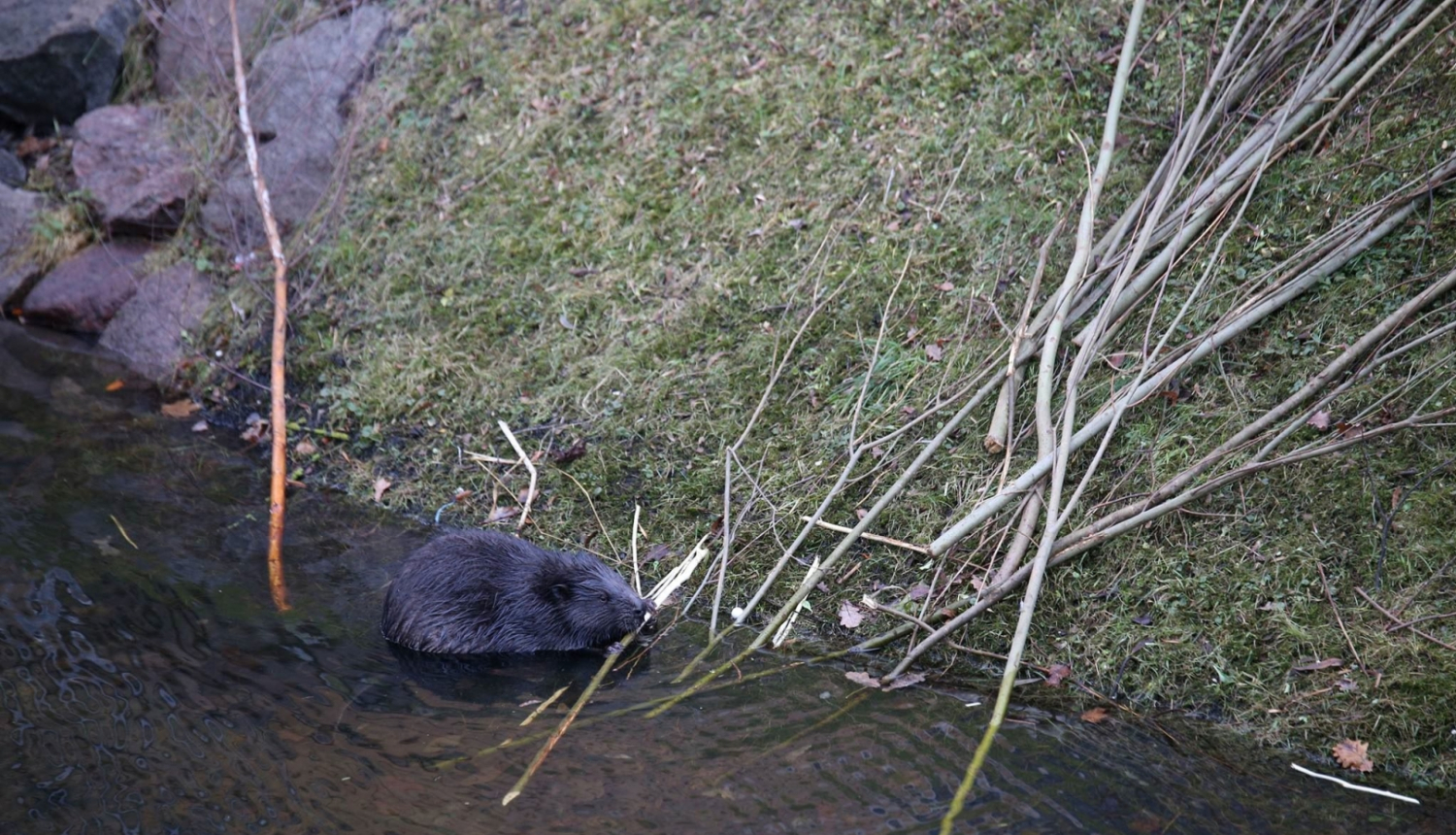Three beavers still live in the Riga City Canal between the Latvian National Opera and Ballet building and the National Theatre, where they bring joy to both Riga residents and visitors during the walks. The municipality has gradually restricted most of the trees with metal fences and will continue to feed beavers with branches, as beavers otherwise tend to cause minor damage to the trees. There are no plans to forcibly relocate these beavers in the next few years.
For several years now, the Riga National Zoo has been monitoring and feeding beavers at the request of the Riga City Council Committee of Housing Environment. Branch deliveries are made about once a week, depending on how much the beavers consume the food. The food supply is more frequent in autumn, as this is when these rodents stockpile food for the winter. They drag large quantities of branches into the water so that they can feast on them underwater when ice covers the water in the winter bitter cold. Whereas in spring and summer, beavers feed on a variety of aquatic plants, so there is little need for branches. The branches are placed in two locations – on the canal embankment opposite the Latvian National Opera and Ballet building on Krišjāņa Barona Street and in front of the University of Latvia Museum building on Kronvalda Boulevard, formerly known as the Faculty of Biology of the University of Latvia.
The monitoring team's observations show that the city canal is home to a single beaver family – two or three animals that replaced the previous owners of the area last year. The beaver family is calm and does not cause significant changes to the city canal, unlike in previous years when the new owners of the area were actively bustling about and creating their own living conditions and a new home.
A monitoring camera is also placed near the feeding points, allowing experts to study the ecology and ethology (animal behaviour) of the beavers living in the canal. Beavers can be seen all along the canal during the summer, but of course they are more likely to be in the vicinity of their burrows. Due to the construction of the Rail Baltica Central Hub in the centre of Riga and the increased disturbance in the construction zone, beavers are avoiding this part of the canal.
There are several hundred other beavers in the capital, whose population has grown rapidly due to favourable conditions, such as a lack of natural enemies. According to the information available to experts, beavers can be found wherever there is water. As large rodents, beavers live in small rivers (Dreiliņupīte, Šmerļupīte, Mārupīte, Langa, Piķurga, Bišumuižas Ditch, Maile Ditch, etc.), as well as in some drainage systems that are away from populated areas, for example along Jaunciema gatve in Trīsciems. Beavers also live in areas where there is no watercourse, but near water – Lucavsala, Ķīpsala, along the River Buļļupe, near Lake Ķīšezers, near Lake Jugla, along the Hapaka Ditch.
Beavers have a strong desire to build dams in streams, ditches and culverts to improve their living conditions, flooding large areas and cutting down or damaging trees over large areas to build the dams. This causes damage to both residents and the municipality – buildings are damaged, forests, meadows, gardens and allotments are flooded.
The municipality regularly clears rivers, drainage ditches and other water bodies of beaver dams (about once every two weeks). Over the past three years, more than € 27 000 has been spent on dam removal and the felling of trees damaged by beavers. Beavers are quick to rebuild dams that have been removed. The total financial loss due to beavers is difficult to calculate, as depletion of natural resources, the impact of increased soil moisture on infrastructure and property, environmental pollution and the use of additional resources to deal with the consequences must also be taken into account.
To address the issue of beaver population and the damage they cause, the Riga City Council's Hunting Coordination Commission, which includes experts from various fields, unanimously decided last year to reduce the number of beavers by using a licensed hunter, since only hunters have the right to regulate wild animal population.
There is no place to relocate beavers because they cause damage to farmers and landowners. It was therefore decided that some beavers living on the outskirts of Riga would be caught using traps. The plan is not to catch all beavers, just to reduce beaver activity so that flood risk prevention and emergency work does not have to be carried out every other week.
Funding was allocated and a tender was launched to limit beaver activity in the capital, but unfortunately no applicants came forward. Subsequently, a negotiation procedure with the hunters was carried out, which resulted in an agreement with one of the hunters for the capture of beavers until the end of 2024. The agreement is worth € 30 000 (an average of € 1 250 per month) and is expected to result in the capture of 60 to 80 beavers during the duration of the agreement.
Under the agreement, the hunter must hunt beavers with traps, which must be checked regularly, and must also dispose of the hunted animals. In addition, the hunter must professionally survey, identify and map beaver habitats and damage areas, monitor beavers with hunting cameras and thermal imaging cameras after dark, and provide the information to the municipality for further analysis.
Riga Municipality takes care of animals on a daily basis - both by controlling stray domestic animals and taking them to shelters, and by transporting large wild animals, such as moose and wild boar, that accidentally find their way to Riga, to forests further away from Riga.
Information prepared by: Mārtiņš Vilemsons, Project Coordinator at the External Communication Department of the Riga City Council’s Communications Board, e-mail: martins.vilemsons@riga.lv.



